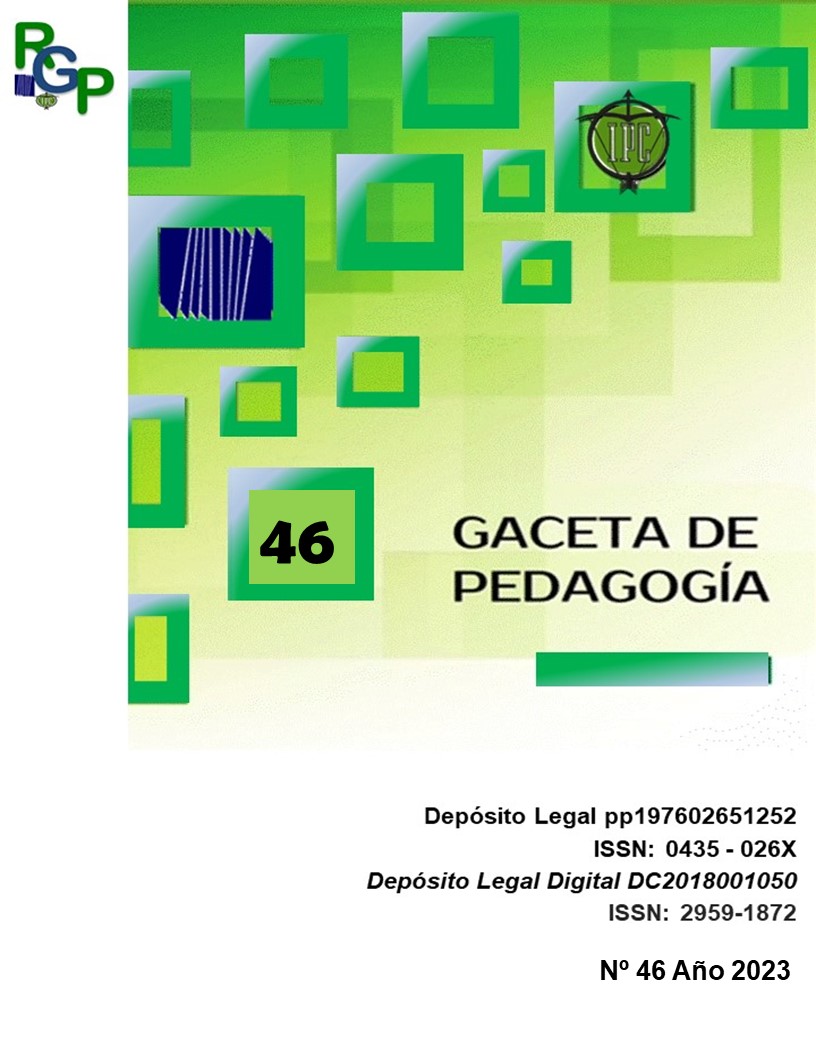Incorporation of the b-learning methodology in the English Teaching process as a second language
DOI:
https://doi.org/10.56219/rgp.vi46.2082Keywords:
B-learning, Teaching and learning, Virtual scenarios, ICTAbstract
The incorporation of blended approaches in education that combine remote and face-to-face training are synonymous with a major and authentic paradigm shift within traditional theories of teaching and learning. The purpose of this study was to provide a reflection on incorporating b-learning methodology in the process of teaching English as a second language. For this systematic review, the following databases were used: Scopus, Scielo and Redalyc, found 240 articles and selected 18 for an in-depth review on the topics of the b-learning approach and the review of these strategies in the teaching of English in higher education institutions. In synthesis, it is established that the incorporation of this approach combined with the use of ICT contributes vehemently to the development of better competencies in English learning and therefore points to a better formation of citizens.
References
Alcalá, F. y Lirola, M. (2008). La comunicación oral del inglés en España: influencia de los aspectos educativos y mediáticos en el éxito del aprendizaje. Revista de Enseñanza Universitaria, (32), 51-63.
Álvarez, V.M., et al. (2008). Presente y futuro del desarrollo de plataformas Web de elearning en educación superior. V Simposio Pluridisciplinar sobre Diseño y Evaluación de Contenidos Educativos Reutilizables. Universidad Pontificia de Salamanca.
Baelo Álvarez, R., (2009). El e-learning, una respuesta educativa a las demandas de las sociedades del siglo XXI. Pixel-Bit. Revista de Medios y Educación, (35), 87-96. https://www.redalyc.org/pdf/368/36812381007.pdf
Bains, M., Reynolds, P.A, McDonald, F y Sherriff, M. (2011) Effectiveness and acceptability of face-to-face, blended and e-learning: a randomised trial of orthodontic undergraduates. Eur J Dent Educ. 15(2):110-7. https://acortar.link/GCUFVc
Belloch, C. (2012). Las Tecnologías de la Información y Comunicación en el aprendizaje. Material docente. Departamento de Métodos de Investigación y Diagnóstico en Educación. Universidad de Valencia. http://www.uv.es/bellochc/pedagogia/EVA1.pdf
Boneu, J.M. (2007). Plataformas abiertas de e-learning para el soporte de contenidos educativos abiertos. Revista de Universidad y Sociedad del Conocimiento, Vol.4, no1. https://acortar.link/ZSFcuv
Cisterna Cabrera, F., (2005). Categorización y triangulación como procesos de validación del conocimiento en investigación cualitativa. Theoria, 14 (1),61-71. ISSN: 0717-196X. https://www.redalyc.org/articulo.oa?id=29900107
Chaves, A. (2017). La educación a distancia como respuesta a las necesidades educativas del siglo XXI. Revista Academia y Virtualidad, 10, (1), 23-41
González, M. E., (2015). El b-learning como modalidad educativa para construir conocimiento. Opción, 31(2), 501-531. https://acortar.link/ignCoZ
Ferriman, N. (2013). The impact of blended e-learning on undergraduate academic essay writing in English (L2). Computers & Education, 60(1), 243-253. https://doi.org/10.1016/j.compedu.2012.07.008
Herrera, B. (2012). Las fuentes del aprendizaje en ambientes virtuales educativos, Revista Complutense de Educación. 2012, v. 23, n. 1; p. 161-188
Hernández, R., Baptista, P., Fernandez C. (2006). Metodología de la investigación. Estado de México, México. McGrawHill
Kavadella, A., Tsiklakis, K., Vougiouklakis, G., & Lionarakis, A. (2012). Evaluation of a blended learning course for teaching oral radiology to undergraduate dental students. Eur J Dent Educ, 16(1), 88–95. https://pubmed.ncbi.nlm.nih.gov/22251359/
Macedo, A., y Finardi, K. (2020). Integrating digital technologies in Brazilian English language Teacher education through blended learning. Educação em Revista, 36, 233799. https://doi.org/10.1590/0102-4698233799
Marqués, P. (2000). Impacto de las TIC en el mundo educativo: funciones y limitaciones de las TIC en educación. Revista de investigación. 2(1), pp 1-15. https://dialnet.unirioja.es/servlet/articulo?codigo=4817326
Morales, S., y Ferreira, A. (2008). La efectividad de un modelo de aprendizaje combinado para la Enseñanza del inglés como lengua extranjera. RLA. Revista de lingüística teórica y aplicada, 46(2), 95-118. https://acortar.link/anJ5Y5
Ortiz, I. (2013). La importancia del idioma inglés en la educación. El Nuevo Diario. Managua, Nicaragua.
Prato, A. y Mendoza, M. (2006). Opinión, conocimiento y uso de portales web para la enseñanza del inglés como lengua extranjera. Enlace, 3(1), 49-61. https://acortar.link/5wZQfw
Pinto, A., Sánchez, M., García, F., y Casillas, S. (2017). Students’ perceptions and attitudes towards asynchronous technological tools in blended-learning training to improve grammatical competence in English as a second language. Computers in Human Behavior, 72, 632-643. https://doi.org/10.1016/j.chb.2016.05.071
Rico, J., Ramírez, M. y Montiel, S. (2016). Development of oral competence through the use of Open Educational Resources. Apertura. https://acortar.link/PqQh49
Saborío-Taylor, S. (2019). Curricular proposal on a blended approach and informative multimedia for didactic resources for the teaching of English courses. Revista Electrónica Educare, 23(3). https://doi.org/10.15359/ree.23-3.11
UNESCO. (2003). La educación en un mundo plurilingüe. https://acortar.link/zt0U6u
Valzacchi, J.R. (2003) Internet y Educación: Aprendiendo y Enseñando en los Espacios Virtuales. AICD, INTERAMER DIGITAL 73. https://acortar.link/EzAoEM
Yang, Y., y Kuo, N. (2021). Blended learning to foster EFL college students’ global literacy. Computer Assisted Language Learning. https://acortar.link/jFHSqp
Published
How to Cite
Issue
Section
License

This work is licensed under a Creative Commons Attribution-NonCommercial-NoDerivatives 4.0 International License.

